MICRO-ORGANISMS
Posted: Tue May 03, 2022 3:34 pm
Microbes in African oceans are the service providers and the critical link in the food chain
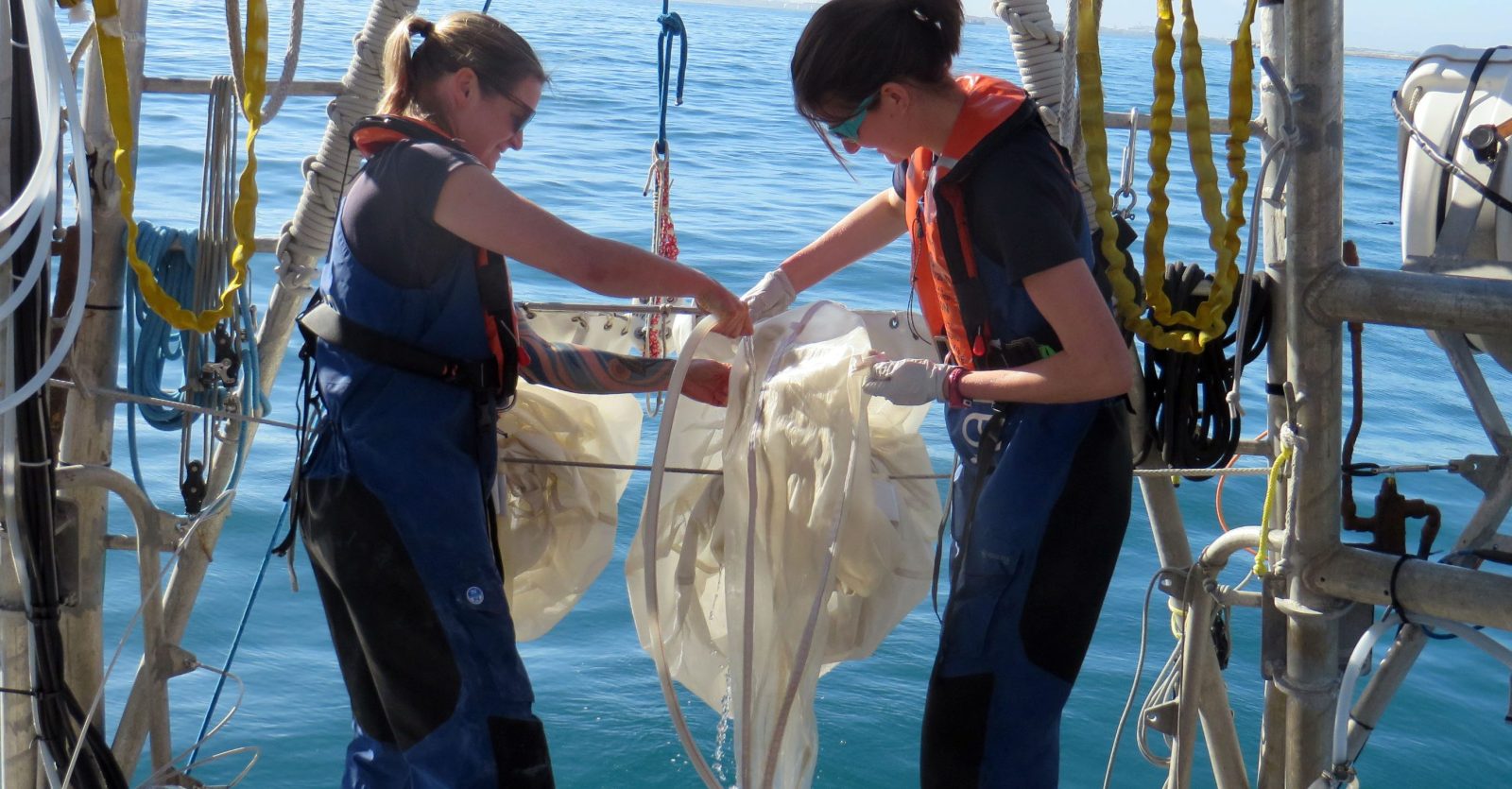
Dr Ali Chase and Clara Trellu, scientists on the schooner Tara, pulling up a net full of microbes. (Photo: Elsabé Brits)
By Elsabé Brits | 02 May 2022
The beings that truly matter to our survival are too small to see with the naked eye and too important to ignore. Micro-organisms produce half our oxygen, but global warming is tipping the scales against us. To survive, we must team up with nature, instead of fighting it, scientists say.
________________________________________________________________________________________________________________________
Microbes in our oceans represent more than two-thirds of the marine biomass, yet little is known about their health status and especially how the climate crisis is affecting this first critical link in the food chain.
These marine algae and photosynthetic bacteria are like service providers. They also capture atmospheric carbon dioxide on a planetary scale and, in return, deliver half the oxygen that we breathe.
Without these microbes, most of which are invisible to the eye, we can’t live.
The Tara Ocean Foundation’s laboratory schooner, Tara, has been studying microbes in the world’s oceans for nearly two years. After completing 53,000km of the 70,000km journey for this mission, it recently docked in Cape Town for the start of the third part of its scientific mission: to focus on the West African coast, including the Benguela Current.
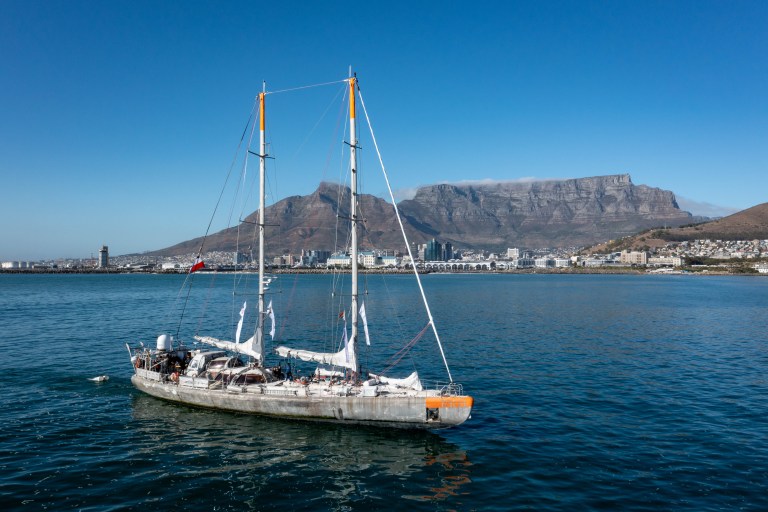
The Tara Ocean Foundation’s laboratory schooner. A net collecting microbes can be seen in the back. (Photo: Maeva Bardy/ Tara Ocean Foundation)
While on this mission the Tara will stop in Namibia, Angola, the Democratic Republic of the Congo, Gambia and Senegal, not only to study the waters but also to pick up local scientists to collaborate with.
Dr Emma Rocke from the University of Cape Town’s Marine and Antarctic Research Centre for Innovation and Sustainability and Professor Thulani Makhalanyane, from the Department of Biochemistry, Genetics and Microbiology at the University of Pretoria, will each spend a month on Tara.
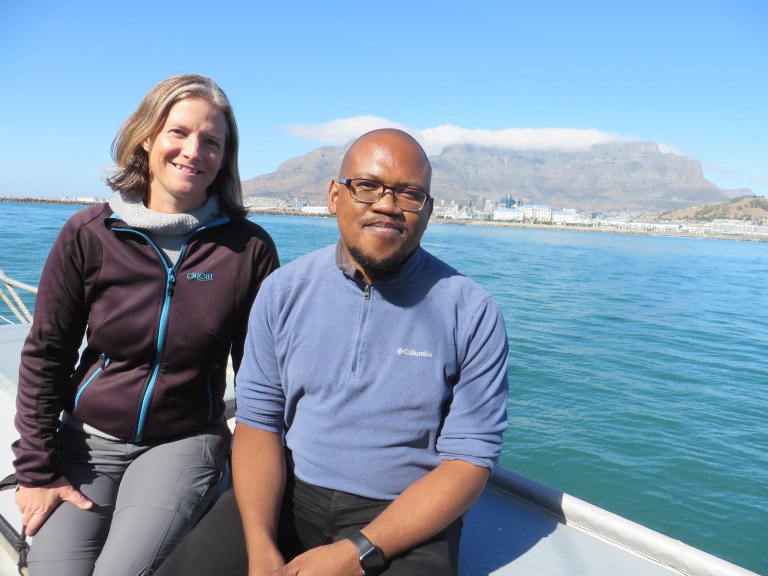
Dr Emma Rocke at the Marine and Antarctic Research Centre for Innovation and Sustainability from the University of Cape Town and Prof Thulani Makhalanyane from the Department of Biochemistry, Genetics and Microbiology at the University of Pretoria, who will each spend a month on the laboratory schooner Tara. (Photo: Elsabé Brits)
The first phenomenon to be studied is the Benguela Current. Rocke explains that oxygen levels in the Benguela Current are low because phytoplankton in the water sink when they die, depleting oxygen. As temperatures rise in the oceans, there is less oxygen available. Current climate models don’t consider what microbes are doing and what will happen to them in the future, and this data is desperately needed.
Every litre of seawater contains between 10- and 100-billion microorganisms. Their sizes range from 0.01 micrometres to 1cm. That’s the same difference in scale as between an ant and a brontosaurus, according to the Tara Ocean Foundation.
“We don’t know what the majority of the microbes in the oceans are, and we should at least get an idea,” Rocke explained. “In areas where there is low oxygen, bacteria grow and they produce nitrous oxide which is 300 times more potent than CO2. We need to know more about where all of this is going.”
Last Saturday a handful of journalists, Rocke and Makhalanyane were invited onboard to experience the workings of the Tara in the waters off Cape Town.
Romain Troublé, executive director of the foundation, explained that they do five types of sampling and have three laboratories on board.
The surface content of the water is pumped and continuously analysed for salinity and temperature in order to compare the different areas.
The manta net collects floating plastic. This is the first time the Tara will collect microplastics on the African West Coast, which has not been studied as much as elsewhere.
Another major interest is the impact the Orange, Congo and Senegal Rivers have on the Atlantic Ocean due to plastic pollution and agricultural nutrients flowing into the sea.
The plankton nets can collect various microbes up to a kilometre deep. One of the masts collects aerosols, including viruses and bacteria; sometimes, they even find microplastics in the air.
To show us the workings of this, the team connects a net with a 0,2mm mesh behind the Tara for about five minutes to catch microorganisms. When they pull it, the contents are filtered again. At the bottom of a container there are millions of reddish looking plankton and some tiny crustaceans.
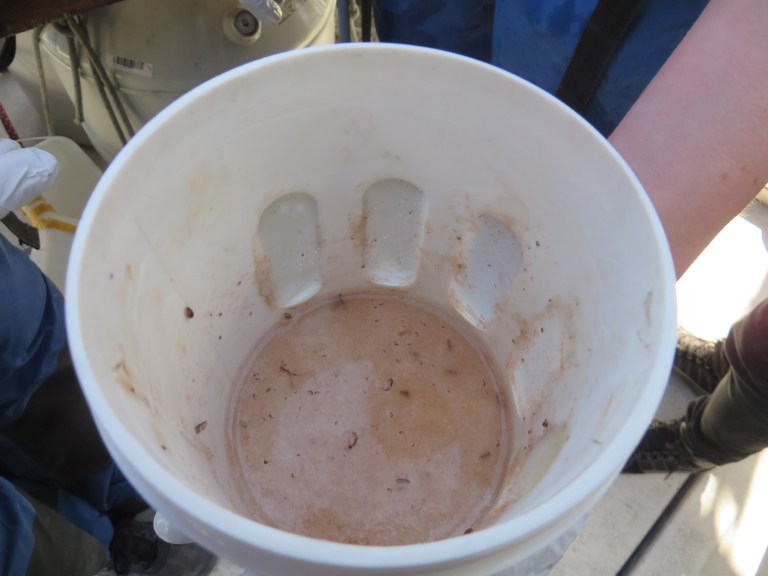
Mostly plankton (reddish) and some crustaceans collected from a net and filter by the Tara Ocean Foundation’s laboratory schooner outside Cape Town. (Photo: Elsabé Brits)
These samples are taken to the wet laboratory on the aft deck for preparation. They will be dried by liquid nitrogen, explains Clara Trellu, a Swiss student onboard. “To do genetic analysis and imaging the samples have to be dry,” she says.
Underneath the schooner is the Rosette, a 250kg aluminium structure which holds 11 bottles programmed to collect samples throughout the day, at various depths. Sensors measure pressure, temperature, oxygen levels, salinity, carbon and even take pictures. This information is conveyed to another laboratory. “The plankton moves through the system in single file so pictures can be taken; it is very precise, ” says Dr Ali Chase, an oceanographer from the University of Washington.
In the dry laboratory the samples are studied and labelled before they are placed in the forward hold in large refrigerators to be sent off to universities at the next stop.
All the scientific equipment makes the living spaces rather cramped. Trellu smiles and comments: “We are not here for ourselves, but for science.”
Makhalanyane says there is great interest in where nutrients are located, how they affect the microbiome, and how they change. The oceans absorb about 40% of the carbon dioxide in the atmosphere: Phytoplankton play a major role in this process, but not much is known about smaller organisms.
By taking samples at various points of different sizes of organisms “we can cover the tree of life”, he explained.
Microbes change in a short span of time and are productive at certain times of day, which is why so little is known about them. “A lot of work has been done in certain areas, like the North Atlantic, but we know less about other regions,” he says.
It is believed that the nutrient levels along the West Coast of Africa are different from other areas, which stands to reason that the microbiome is also different. Forecasts can be made according to the pH-level of the water on how the microbes would behave, which could be included in climate change models.
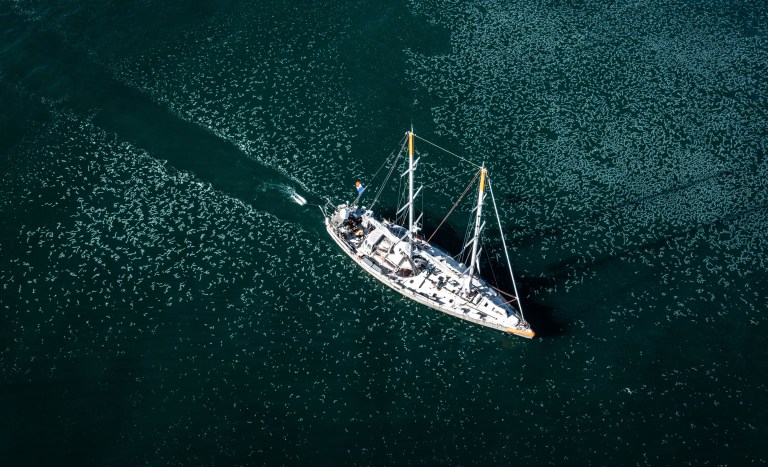
The Tara Ocean Foundation’s laboratory schooner. The numerous white spots are air bubbles in the water. A net colleting microbes can be seen in the back. (Photo: Maeva Bardy/ Tara Ocean Foundation)
Troublé says Covid-19 showed that evolution of the virus took place in front of our eyes: “It happens in the oceans all the time. During the last 10 years we found 100,000 new plankton species and 180-million new genes. But the next step needs to be how the microbes are changing and how much climate change is affecting them”.
He added that the “ecosystem is moving from the tropics to the poles, because it is too warm. A huge migration is happening. We have to prove this with scientific data to explain it to politicians, because there is a communication gap between science and politics. Our whole way of thinking has to change: science brought us all here, and it should take us into the future.
“During the last 30 years basically everything has changed. But, what has not changed is the fact that we are still fighting nature, we need to team up with it. We can’t live without it. Millions of years of evolution brought us here and we are still fighting it. It is time to remember we are part thereof,” says Doublé. DM

Dr Ali Chase and Clara Trellu, scientists on the schooner Tara, pulling up a net full of microbes. (Photo: Elsabé Brits)
By Elsabé Brits | 02 May 2022
The beings that truly matter to our survival are too small to see with the naked eye and too important to ignore. Micro-organisms produce half our oxygen, but global warming is tipping the scales against us. To survive, we must team up with nature, instead of fighting it, scientists say.
________________________________________________________________________________________________________________________
Microbes in our oceans represent more than two-thirds of the marine biomass, yet little is known about their health status and especially how the climate crisis is affecting this first critical link in the food chain.
These marine algae and photosynthetic bacteria are like service providers. They also capture atmospheric carbon dioxide on a planetary scale and, in return, deliver half the oxygen that we breathe.
Without these microbes, most of which are invisible to the eye, we can’t live.
The Tara Ocean Foundation’s laboratory schooner, Tara, has been studying microbes in the world’s oceans for nearly two years. After completing 53,000km of the 70,000km journey for this mission, it recently docked in Cape Town for the start of the third part of its scientific mission: to focus on the West African coast, including the Benguela Current.

The Tara Ocean Foundation’s laboratory schooner. A net collecting microbes can be seen in the back. (Photo: Maeva Bardy/ Tara Ocean Foundation)
While on this mission the Tara will stop in Namibia, Angola, the Democratic Republic of the Congo, Gambia and Senegal, not only to study the waters but also to pick up local scientists to collaborate with.
Dr Emma Rocke from the University of Cape Town’s Marine and Antarctic Research Centre for Innovation and Sustainability and Professor Thulani Makhalanyane, from the Department of Biochemistry, Genetics and Microbiology at the University of Pretoria, will each spend a month on Tara.

Dr Emma Rocke at the Marine and Antarctic Research Centre for Innovation and Sustainability from the University of Cape Town and Prof Thulani Makhalanyane from the Department of Biochemistry, Genetics and Microbiology at the University of Pretoria, who will each spend a month on the laboratory schooner Tara. (Photo: Elsabé Brits)
The first phenomenon to be studied is the Benguela Current. Rocke explains that oxygen levels in the Benguela Current are low because phytoplankton in the water sink when they die, depleting oxygen. As temperatures rise in the oceans, there is less oxygen available. Current climate models don’t consider what microbes are doing and what will happen to them in the future, and this data is desperately needed.
Every litre of seawater contains between 10- and 100-billion microorganisms. Their sizes range from 0.01 micrometres to 1cm. That’s the same difference in scale as between an ant and a brontosaurus, according to the Tara Ocean Foundation.
“We don’t know what the majority of the microbes in the oceans are, and we should at least get an idea,” Rocke explained. “In areas where there is low oxygen, bacteria grow and they produce nitrous oxide which is 300 times more potent than CO2. We need to know more about where all of this is going.”
Last Saturday a handful of journalists, Rocke and Makhalanyane were invited onboard to experience the workings of the Tara in the waters off Cape Town.
Romain Troublé, executive director of the foundation, explained that they do five types of sampling and have three laboratories on board.
The surface content of the water is pumped and continuously analysed for salinity and temperature in order to compare the different areas.
The manta net collects floating plastic. This is the first time the Tara will collect microplastics on the African West Coast, which has not been studied as much as elsewhere.
Another major interest is the impact the Orange, Congo and Senegal Rivers have on the Atlantic Ocean due to plastic pollution and agricultural nutrients flowing into the sea.
The plankton nets can collect various microbes up to a kilometre deep. One of the masts collects aerosols, including viruses and bacteria; sometimes, they even find microplastics in the air.
To show us the workings of this, the team connects a net with a 0,2mm mesh behind the Tara for about five minutes to catch microorganisms. When they pull it, the contents are filtered again. At the bottom of a container there are millions of reddish looking plankton and some tiny crustaceans.

Mostly plankton (reddish) and some crustaceans collected from a net and filter by the Tara Ocean Foundation’s laboratory schooner outside Cape Town. (Photo: Elsabé Brits)
These samples are taken to the wet laboratory on the aft deck for preparation. They will be dried by liquid nitrogen, explains Clara Trellu, a Swiss student onboard. “To do genetic analysis and imaging the samples have to be dry,” she says.
Underneath the schooner is the Rosette, a 250kg aluminium structure which holds 11 bottles programmed to collect samples throughout the day, at various depths. Sensors measure pressure, temperature, oxygen levels, salinity, carbon and even take pictures. This information is conveyed to another laboratory. “The plankton moves through the system in single file so pictures can be taken; it is very precise, ” says Dr Ali Chase, an oceanographer from the University of Washington.
In the dry laboratory the samples are studied and labelled before they are placed in the forward hold in large refrigerators to be sent off to universities at the next stop.
All the scientific equipment makes the living spaces rather cramped. Trellu smiles and comments: “We are not here for ourselves, but for science.”
Makhalanyane says there is great interest in where nutrients are located, how they affect the microbiome, and how they change. The oceans absorb about 40% of the carbon dioxide in the atmosphere: Phytoplankton play a major role in this process, but not much is known about smaller organisms.
By taking samples at various points of different sizes of organisms “we can cover the tree of life”, he explained.
Microbes change in a short span of time and are productive at certain times of day, which is why so little is known about them. “A lot of work has been done in certain areas, like the North Atlantic, but we know less about other regions,” he says.
It is believed that the nutrient levels along the West Coast of Africa are different from other areas, which stands to reason that the microbiome is also different. Forecasts can be made according to the pH-level of the water on how the microbes would behave, which could be included in climate change models.

The Tara Ocean Foundation’s laboratory schooner. The numerous white spots are air bubbles in the water. A net colleting microbes can be seen in the back. (Photo: Maeva Bardy/ Tara Ocean Foundation)
Troublé says Covid-19 showed that evolution of the virus took place in front of our eyes: “It happens in the oceans all the time. During the last 10 years we found 100,000 new plankton species and 180-million new genes. But the next step needs to be how the microbes are changing and how much climate change is affecting them”.
He added that the “ecosystem is moving from the tropics to the poles, because it is too warm. A huge migration is happening. We have to prove this with scientific data to explain it to politicians, because there is a communication gap between science and politics. Our whole way of thinking has to change: science brought us all here, and it should take us into the future.
“During the last 30 years basically everything has changed. But, what has not changed is the fact that we are still fighting nature, we need to team up with it. We can’t live without it. Millions of years of evolution brought us here and we are still fighting it. It is time to remember we are part thereof,” says Doublé. DM